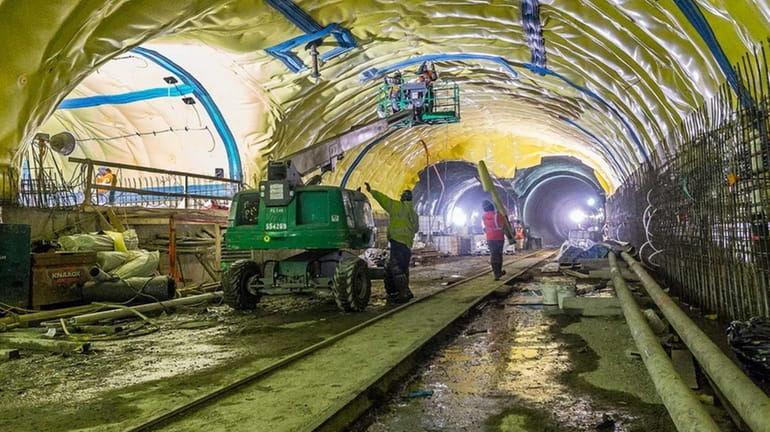Payout cap on Sandy damage may delay rehab of tunnels used by LIRR

Work continues on the Manhattan side of the East Side Access Project below Grand Central Terminal with waterproofing, rebar arch installation and drilling for couplers on Jan. 29, 2015. Credit: MTA Capital Construction / Rehema Trimiew
A federal court ruling capping how much insurance companies will have to pay out for superstorm Sandy damage to the East River tunnels primarily used by the LIRR could cause big delays to planned repairs as the tunnels' owner, Amtrak, scrambles to find money for the fixes, officials said.
The project, proposed last year by Amtrak, would rehabilitate two of the four rail tunnels running between Queens and Penn Station -- a massive undertaking that would require removing each of the two tunnels from service for a year at a time and cost "several hundred million dollars," according to the agency.
However, a recent U.S. District Court ruling in a lawsuit between Amtrak and several insurance companies limited the insurance payout to Amtrak for the tunnel damage to just $125 million. That's enough to move forward with ongoing work to design the project, but not nearly enough for its construction, which Amtrak hopes to begin in two to three years.
"The longer we prolong use of this asset in its current condition, the greater chance of disruptions," said Stephen Gardner, Amtrak's vice president of Northeast Corridor Infrastructure and Investment Development. "Every day we delay fixing this problem adds to the risks of greater trains delays in the future."
The tunnels were inundated with 14 million gallons of floodwaters during the October 2012 storm, and Amtrak officials said corrosive salts and chlorides left behind have continued to deteriorate the underground structures.
U.S. District Judge Jed Rakoff sided with insurance providers in ruling that the tunnel damage falls within a $125 million limit for flood damage. Amtrak, in a $1.1 billion suit filed earlier this year, argued that the damage was caused by wind-driven storm surges, which are different from flood, and that the water and salt damage were separate.
Gardner noted that the East River tubes are actually in worse shape than those running under the Hudson River. Electrical problems in those tunnels snarled New Jersey Transit for several days last month, and accelerated talks between Amtrak and government officials on building new tunnels.
Although Amtrak has said there is no imminent safety risk, problems in the century-old East River tunnels have become far more frequent since Sandy.
According to the Long Island Rail Road, which runs about half of all trains through the tunnels, delays caused by Amtrak, which maintains the tunnels, rose to 1,458 incidents last year from 817 in 2012 -- an increase of nearly 80 percent.
In the first half of 2015 alone, the LIRR reported 969 Amtrak-related delays.
Gardner said an additional snag involves another critical LIRR project, East Side Access, which aims to link the railroad to Grand Central Terminal by 2022.
Because both efforts involve extensive work at the busy Harold Interlocking in Queens, Amtrak and the MTA need to sync their respective schedules. So a delay to one project could mean a delay to the other.
Sen. Chuck Schumer (D-N.Y.) said the East Side Access complications are another reason there's "no time to waste in rebuilding the East River tunnels."
"Sequencing the tunnel work along with the work needed for East Side Access is critical so both projects can be completed without risking further delays to LIRR or Amtrak passengers," said Schumer, adding that he will work to find additional federal funding for the tunnel project. "The news about this insurance ruling is a setback but we cannot let it derail these two critical projects."
Without the insurance money Amtrak was banking on, or federal aid in the form of additional Sandy funding or other grants, Gardner said the railroads that use the tunnels -- Amtrak, New Jersey Transit and the LIRR -- would have "big expenses."
An MTA spokesman declined to comment.
MTA Board member Mitchell Pally, of Stony Brook said, "Regardless of who pays," putting off repairs any further is not an option.
"We are not going to subject our riders to infrastructure that is not adequate for our needs," Pally said. "They need to do the work they promised, and they need to do it on time."
Updated 28 minutes ago Gilgo task force expands scope ... Digging continues at Bethpage park ... Fee for online ticket payments ... FeedMe: Seafood
Updated 28 minutes ago Gilgo task force expands scope ... Digging continues at Bethpage park ... Fee for online ticket payments ... FeedMe: Seafood


